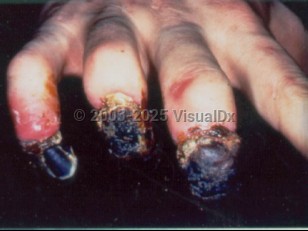Rapid patient isolation, use of personal protective equipment for health care workers, antibiotic delivery, and notification of public health professionals are essential preliminary steps when the disease is suspected. Supportive care in the intensive care unit may be necessary. Patients may require respiratory support and mechanical ventilation as well as fluid resuscitation and blood pressure support.
- Antibiotic treatment should begin as soon as plague is suspected. Pretreatment samples (blood, sputum, lymph node / bubo aspirates) should be collected if possible but should NOT delay treatment.
- Control measures and personal protective equipment for health care workers should be geared toward droplet / contact transmission at a minimum. Consult infection control experts to determine whether additional protection is warranted for caring for patients with potential aerosolizing interventions (eg, high-flow nasal cannula supplemental oxygen delivery).
Infection with the gram-negative bacillus Yersinia pestis, commonly referred to as the plague, is a highly lethal disease that requires rapid, early recognition and prompt treatment. The septicemic form is the rarest manifestation of plague. It occurs when the bacteria disseminate through the bloodstream and culminates in severe sepsis and ultimately death if untreated. Early treatment (<24 hours from symptom onset) may reduce mortality. Nonetheless, even with treatment, mortality approaches 40%.
Primary septicemic plague results from direct inoculation of the bacteria into the bloodstream, typically via the bite of an infected animal or flea or direct contact with infected tissues. Secondary septicemic plague occurs when there is progression of disease and dissemination of bacteria following bubonic presentation. Bubonic plague is the most common form of the disease in humans.
Septicemic plague has sudden onset and rapid progression (with an incubation period of 1-6 days) causing fever, chills, weakness, abdominal pain, shock, and bleeding underneath the skin or other organs and may result in disseminated intravascular coagulation (DIC), necrosis of small vessels, and purpura. Acral regions such as the fingers, toes, and nose may become gangrenous, hence the term "black death." Alone, septicemic plague is rarely transmissible human to human but may become transmissible if the disease reaches the pneumonic stage or is associated with buboes.
It is important to recognize that the initial symptomatology is nonspecific and commonly seen in many types of severe bacterial sepsis, so the clinician must have a high index of suspicion based on endemic locations, recent travel, and close contact with rodents or domestic animals that have recently become sick.
Initial diagnosis in the emergency department may be difficult. Unless the link to exposure is readily apparent, most cases will be diagnosed after admission based on microbiologic culture data or PCR (sputum or blood). The clinician must have a high index of suspicion based on endemic locations, recent travel, and close contact with rodents or domestic animals that have recently become sick.
If the outbreak is intentional and patients with plague have been identified in the community, all patients presenting with sepsis should be considered to have plague unless an alternate diagnosis is found. Human-to-human transmission is possible in secondary septicemia due to pneumonic plague, so if septicemic plague is suspected, appropriate infection control practices must be rapidly implemented. Control measures and personal protective equipment for health care workers should be geared toward droplet / contact transmission at a minimum. Consult your infection control experts to determine whether additional protection is warranted.
Plague is classified as a Category A bioterrorism agent because of its ease of dissemination, contagiousness, and high mortality rate. The most likely method of dispersal would be as an aerosol, but simply having an infected individual walk around infecting others is another possible mode of dissemination, albeit less efficient at making many persons ill. Concern for bioterrorism should be raised if multiple patients arrive with similar symptoms suspicious for plague, especially when urban-dwelling persons without any identified exposure become ill.
Rapid patient isolation, use of personal protective equipment for health care workers, antibiotic delivery, and notification of public health professionals are essential preliminary steps when the disease is suspected. The clinician should have a low threshold to activate the hospital incident command system and notify public health authorities.
Endemic plague is seen in the western United States (Colorado, New Mexico, Arizona, California, southern Oregon, and Nevada) as well as in central and southern Africa (Democratic Republic of Congo, Uganda, Madagascar), parts of South America (Peru), and central Asia and the Indian subcontinent. Hikers, campers, veterinarians, and owners of infected cats, especially those living in or visiting endemic areas, are at greater risk for contracting plague.
Other risk factors include a rural or nonurban environment, especially in known endemic areas; contact with sick or dead animals, especially small rodents or other possible hosts; wilderness activities; known flea bite; occupation as veterinarian; and recent plague in the community.



